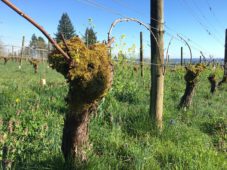Irrigation: the oxycontin of viticulture
From John, March 30th, 2019
old non-irrigated vine
It makes everything feel good but it is terribly addictive and the health of the patient is always compromised. I am talking of course about irrigating vineyards in North America.
Certainly Europe would have to be considered the progenitor of American viticulture and their vineyards are largely dry farmed. And in the beginning, and until quite recently, vineyards in America were also dry farmed.
So what happened? After the famous Steven Spurrier Tasting in 1976 (won by Stags Leap Winery and Chateau Montelena), investment in vineyards started pouring into the Napa Valley and California viticultural areas in general. With that money came bankers and accountants demanding return on their investments. And to ease the pain of those hefty financial transactions, vineyards began irrigating. With irrigation, vines could be in production in 2 years instead of 5-7, yields could be increased and the quantity of sugar in the grapes could be pushed to previously unknown levels.
Note that nothing has been said about “quality” here. As yields went up, quality went down and as sugars went up, California wines became known as high alcohol fruit bombs. By comparison the beautifully crafted wines that won the Paris Tasting in 1976 were all around 12.5% alcohol. You would be hard pressed to find a Napa Valley wine today that is less than 14-15% alcohol (unless it comes from one of the remaining dry farmed vineyards such as Frog’s Leap).
In Europe, if one introduces irrigation to one’s vineyard, one immediately loses rights to an appellation because rainfall (timing and quantity) is a basic component of terroir. Irrigated vineyards have no more terroir than a hydroponically grown green house tomato.
The Oregon wine industry basically copied the California model approximately 10 years later. In our case, a tasting of Burgundies vs Oregon Pinot noirs took place with wines from our 1983 vintage. And again, with the fame garnered by the results, money poured into the Willamette Valley tethered to grandiose schemes for irrigating the new vineyards. The results have been largely the same with a plethora of high alcohol, fruit-forward wines.
The good news is that there are still plenty of dry farmed vineyards in both Oregon and California. Though they constitute a minority of the plantings, they are certainly producing the best wines. Many of these vineyards are represented by the Deep Roots Coalition.
Share ThisRecent News & Rants
The ICE Age
The agricultural sector of our country absolutely relies immigrants to produce the food that we eat and the wine that we drink. At Cameron we rely on the Latino workforce to accomplish many of the tasks in our vineyards. We simply cannot do it all ourselves. From pruning to pulling leaves around the fruit to harvesting in the Fall, they are a vital part of the process. And without them we will not exist.
There’s More... >The Plague
Phylloxera, an aphid which feeds on grapevine roots and leaves, is a plague that occurs in nearly all viticultural regions around the world. Read on to understand how and why this pest was first introduced and how it is managed today.
There’s More... >Winter Chores
Now that wines from the just-completed vintage are resting in their barrels, we turn our attention to the vineyard, to blending and to bottling.
There’s More... >

